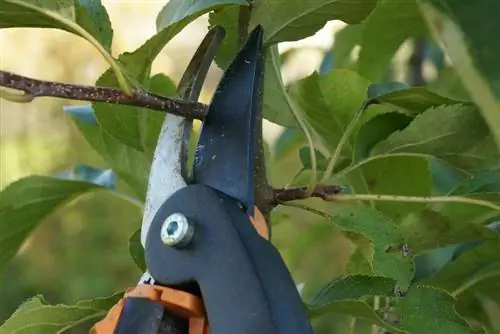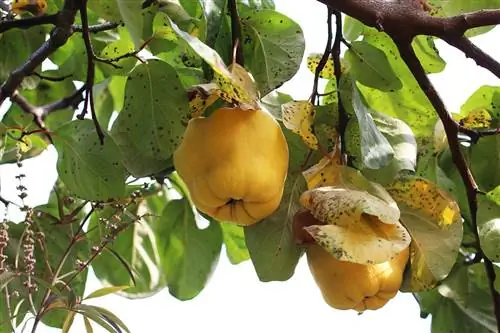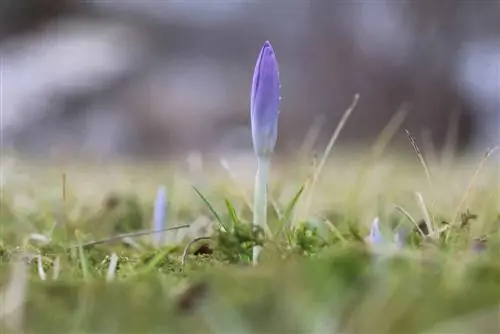- Author admin [email protected].
- Public 2023-12-17 03:39.
- Last modified 2025-06-01 06:48.
Admittedly, pruning fruit trees correctly is not that easy. Beginners in particular regularly have problems with this. The fear of doing something wrong and causing massive damage to the tree is often great. You are welcome to forego the cut. The whole thing is not as difficult as it first seems. With a few basic rules and a little patience, pruning fruit trees can be done easily by practically anyone. The reward is lush trees and a bountiful harvest.
Why cut?
Of course, in this context the question immediately arises as to why pruning fruit trees is even necessary. It doesn't exist in the wild either. The answer to this question: To ensure that the tree lives as long as possible and to be able to reap a rich harvest with lots of he althy fruits. You should also say goodbye to the romantic idea of wild fruit trees. The trees that usually grow in our gardens are special breeds, some of which differ significantly from their wild brothers.
Consequently, they also need attention or more intensive attention. Especially in the first few years after planting, the tree needs to be trained to a certain extent. The main focus is on forming a lush crown and building a stable supporting framework. After all, the branches have to be able to withstand a heavy fruit load as well as high snow pressure in winter. Other reasons for pruning fruit trees are:
- the first harvest is possible at an earlier date
- better fruit quality due to higher light transmission in the crown
- harvesting becomes easier with easier accessibility
- Fluctuations in yield are mitigated
- the fruit tree lives longer and is more productive overall
It's best if you see the fruit tree pruning as a way of caring for the tree. Cutting it makes it stronger. If cut properly, it is better protected against diseases and pests. In short: pruning fruit trees brings with it a whole range of advantages that you shouldn't miss out on as a hobby gardener.
When to cut?
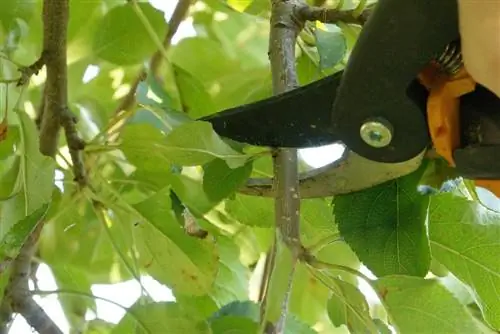
Many people think that fruit trees need to be pruned in autumn. However, this is a myth and in the worst case scenario it can even lead to significant problems. Basically, there are only two periods during the year when pruning takes place - namely winter and summer. The so-called winter pruning takes place in the months of December, January, February to mid-March. It is used for pome, stone and berry fruits. However, it is important that the temperature during the cut must not fall below minus five degrees Celsius, otherwise the tree could have problems. The so-called summer pruning, in turn, primarily affects cherry trees that are pruned either parallel to the harvest or immediately after the harvest. In addition, young trees are also pruned in the months of July and August. The summer cut in particular has an extremely positive effect:
- the size of the fruits and their color improve
- the flower buds are encouraged
- wound healing after the cut is significantly better
- growth weakens in shooty trees
Tip:
Winter pruning is only carried out if there are several mild and frost-free days in a row.
Tools
Even if there is traditionally a lot of talk about cutting when pruning fruit trees, in reality the work involved has more to do with sawing. Branches can only be cut off up to a certain diameter. Most of the time this only works with fine branches. The best way to do this is to use one-handed pruning and pruning shears. However, thick branches are cut off with a hacksaw or a folding saw. The folding saw is much easier to handle. Some models also offer the advantage that they can be attached to a telescopic extension, which makes access to higher branches possible even without a ladder. In order to achieve the smoothest possible cutting surface, the saw blade should have sufficient sharpness. The easier it is to saw, the better it is for the tree.
Cutting - the basics
There are a few basic rules and regulations when pruning fruit trees that you should definitely follow. These include, among others, the following:
- A strong pruning leads to strong budding
- weak pruning leads to weak shoots
- uneven pruning leads to irregular shoots
Regardless of these points, the correct pruning technique when pruning fruit trees also plays a major role in the success of the respective measure. For example, when cutting branches, you should always make sure that the cut is made towards a branch ring. The cutting surface must be smooth and slightly angled. It is important to avoid creating a so-called “hat hook”. This can break easily. Disease germs and pests then find their way into the tree through the unintentionally created wound.
In order to redirect the growth or direction of growth from a main branch to a side branch, the main branch is cut directly at the base of the side branch with the cutting surface angled slightly downwards. This should again be plan. Overall, there are four types of pruning or pruning methods when pruning fruit trees, some of which only affect certain phases of the tree's life:
- Plant cutting
- Educational Cut
- Conservation cut
- Rejuvenation cut
The aim of these four pruning methods is always to achieve the most harmonious relationship possible between the factors of growth, flower formation and fruit setting.
Plant cutting
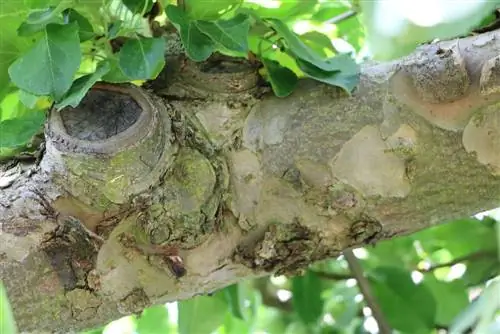
The planting cut is, so to speak, the first cut that the tree gets in your own garden. If planting takes place in autumn, cutting will not take place until the following winter months or spring. The so-called leading shoots are shortened. Lead shoots are those branches that then form the tree crown at a later stage. The following applies: Weak leading shoots are cut back by half, while strong shoots are only cut back by around a third. All shoots that are below the future crown base are cut off completely.
Educational Cut
The aim of the training cut is to ensure that the most stable bearings and fruitful side shoots possible can develop. To do this, all shoots that grow steeply inwards are consistently removed. In addition, the ends of the main branches must be shortened. By the way, a fruit tree in the garden usually has three to four of these main branches. The aim is to create a pyramid-shaped crown.
Conservation cut
When people generally talk about pruning fruit trees, they usually mean maintenance pruning. It takes place at least once a year as soon as the tree bears fruit. The aim is to achieve the most balanced possible relationship between the growth of the tree on the one hand and the fruit yield on the other. In the first step, all branches and shoots that are no longer of any use to the tree or could harm it are removed:
- Dead wood, i.e. branches that have already died
- Branches that are diseased or have pest infestation
- all water levels
- Shoots that no longer want to bloom
Tip:
The water shoots that grow steeply upwards do not necessarily have to be cut off, but can also be removed by hand by tearing them off or bending them. This often makes work easier.
After this first step, the treetop should be well illuminated. The following applies: As soon as you can comfortably work in the crown while standing on a ladder without being bothered by branches, the thinning is sufficient. That means most of the work is done. In a second step, all older and widely branched branches that only bear a few or extremely small fruits must now be removed. Although this measure leads to a smaller yield in the next harvest, it guarantees a higher harvest of fruit in the long term. Once this is finally done, the branches that only grow inwards should be cut off. They can significantly impair the circulation of air and thus lead to the tree contracting a fungal infection.
Rejuvenation cut
Older fruit trees that have not been pruned for several years may look quite impressive, but often no longer bear much fruit. In order to bring them back into shape and increase harvest success, the so-called rejuvenation cut is carried out. In a sense, it works like a fresh cell treatment for the tree. To ensure that this really works, the crown is thinned out very generously in the spring. In particular, it is important to consistently remove all very old and overhanging fruit branches. The tree will then develop a lot of unwanted water shoots in the summer months. These must be removed regularly and ideally as early as possible. The following year, the rejuvenation cut for the tree is finally completed with a conventional maintenance cut. From then on, the yield will gradually increase again.
Conclusion
Pruning fruit trees is neither magic nor an insurmountable hurdle. It can actually be implemented relatively easily if you follow a few basic rules. If you work carefully and carefully, there is no danger to the tree. The opposite is more likely to be the case: the tree will grow better and bear more fruit. If you still have concerns about just reaching for pruning shears or a saw, we recommend attending a tree pruning course. Here you learn how to do it step by step and can look over the shoulders of professionals. However, such a course is not absolutely necessary. The first fruit tree pruning usually just takes a bit of effort. The next maintenance cut usually makes it much easier.

